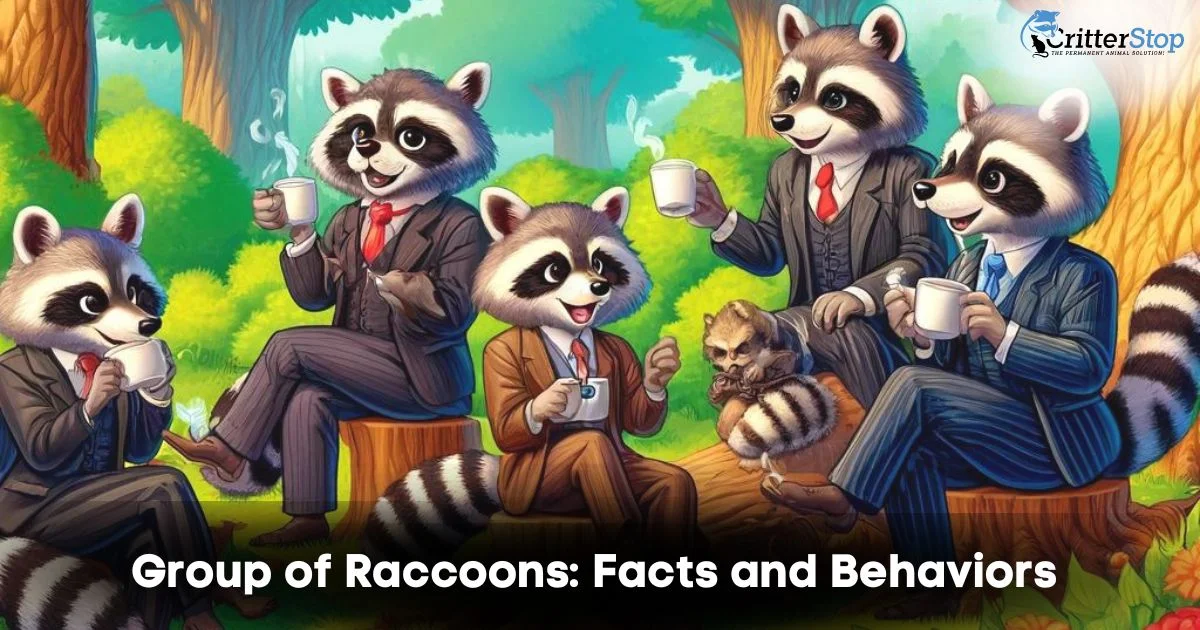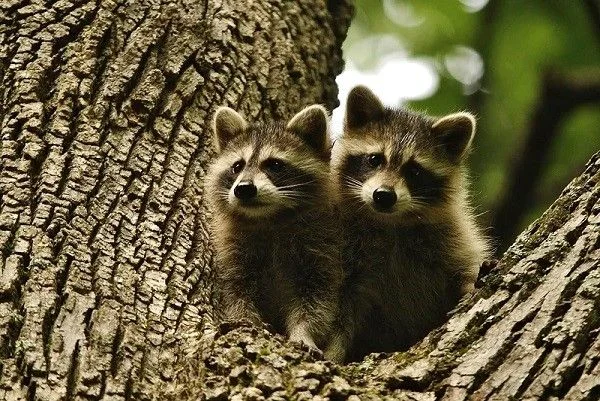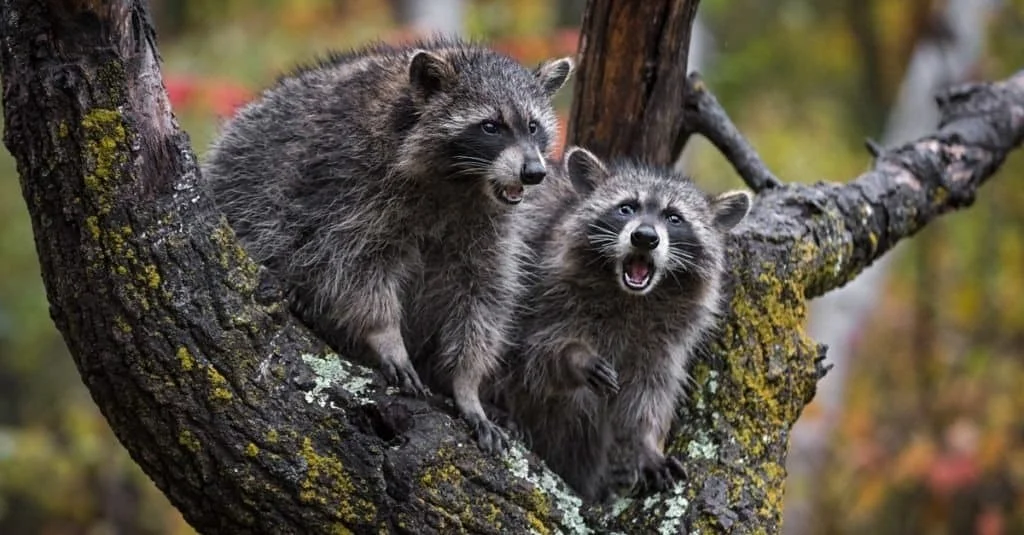
A group of raccoons is known as a "gaze," and they are fascinating creatures that are native to North America. These small mammals are known for their distinctive black "mask" around their eyes and their ringed tails. They are also known for their intelligence and adaptability, which has allowed them to thrive in a variety of environments, from forests to urban areas.
Raccoons are social animals and often live in groups of up to 20 individuals. Typically, these clusters consist of mother figures and their offspring, with males only entering the fold during the breeding period. Within the group, raccoons have a complex social hierarchy, the most influential members within these groups usually secure the finest resources and chances for mating
Despite their cute and cuddly appearance, raccoons can be a nuisance for homeowners, as they are known to raid garbage cans and cause damage to gardens. However, with their fascinating behavior and adaptability, it's hard not to appreciate these clever creatures as they navigate their way through the world.

Raccoons are known to be solitary animals, but if you were asking if do raccoons live in groups, yes, they do live in groups, especially during the mating season. The group dynamics of raccoons are complex, and they have a well-defined social structure.
Raccoons are not pack animals, but they do form loose social groups. Traditionally, these groups comprise females and their offspring, with males adopting a solitary lifestyle and only integrating into the group during mating seasons.
The females in the group have a hierarchical structure, with the older and more dominant females leading the group. The younger females are subordinate to the older ones and follow their lead.
Raccoons are territorial animals and will defend their territory against other raccoons. They use scent marking and vocalizations to communicate with other raccoons and establish their territory.
The size of a raccoon's territory depends on the availability of food and other resources. In urban areas, raccoons may have smaller territories because of the abundance of food.
In conclusion, is probably that you won’t find a pack of raccoons just hanging out, but yes, they do live in groups, especially during the mating season. The females in the group have a well-defined social structure, with the older and more dominant females leading the group. Raccoons are also territorial animals and will defend their territory against other raccoons.

Raccoons are known for their intelligence and adaptability, which is reflected in their behavioral patterns. Understanding the behavior of these animals can offer valuable understanding of their tactics for survival and their interactions with their surroundings.
Raccoons are primarily nocturnal animals, and they are known for their opportunistic feeding habits. They have an omnivorous diet, consuming both plant-based and animal-based foods. Raccoons are known to eat fruits, nuts, insects, small mammals, and fish.
When foraging for food, raccoons tend to be solitary creatures. They are not known to run in packs, and they typically hunt and gather food on their own. However, it is not uncommon to see multiple raccoons in the same area, especially if there is an abundance of food available.
Raccoons are skilled hunters, and they have a variety of hunting practices that they use to catch their prey. They are known for their ability to climb trees and swim, which allows them to access a wider range of prey.
Unlike some other animals, raccoons do not hunt in packs. They are solitary hunters, and they typically hunt and gather food on their own. However, they may occasionally share a food source with other raccoons if there is an abundance of food available.
In conclusion, raccoons have unique behavioral patterns that allow them to thrive in a variety of environments. While they are primarily solitary creatures, they are adaptable and opportunistic in their feeding habits and hunting practices.
Raccoons are known to be highly social animals and are often seen in groups. These groups are called a variety of names depending on the context and the number of raccoons present.
The most commonly used term for a group of raccoons is a "nursery" or a "kit," which refers to a group of baby raccoons and their mother. However, adult raccoons can also be found in groups, and in this case, they are referred to as a "gaze" or a "mask."
Are raccoons pack animals? No. It is important to note that raccoons are not pack animals, and they do not live in packs. Instead, they form loose associations with other raccoons, often sharing a den or foraging area. These associations can change frequently, with raccoons joining and leaving the group as needed.
In addition to these terms, there are a few other less commonly used terms for groups of raccoons. A group of raccoons can also be referred to as a "clowder," a "dray," or a "pandemonium." However, these terms are not as widely recognized or used as the previously mentioned terms.
Overall, understanding the terminology used to describe groups of raccoons can help individuals better understand these social animals and their behavior.
Raccoons are versatile animals capable of thriving in various habitats, including urban areas. However, their natural habitat is in forested areas near water sources. Habitat loss due to deforestation, urbanization, and pollution has led to a decline in raccoon populations. Therefore, conservation efforts must focus on protecting and restoring raccoon habitats.
One effective way to protect raccoon habitats is through the creation of wildlife corridors. These are corridors of land that link fragmented habitats together, allowing animals to move between them. Wildlife corridors provide raccoons with access to food, water, and potential mates, which can help to maintain genetic diversity and ensure the well-being of the species.

Raccoons are recognized for their knack for adjusting to human-influenced environments, which has led to an increase in their interactions with people. While raccoons can be a nuisance, they also play an important role in the ecosystem. They help to control insect and rodent populations and serve as prey for larger predators.
To manage raccoon populations, it is important to implement humane and effective methods. This involves educating the public on methods to prevent conflicts with raccoons, such as securing garbage cans and removing potential food sources. In cases where raccoons become a nuisance, relocation or exclusion may be necessary.
Overall, conservation and management efforts must balance the needs of both raccoons and humans. By protecting raccoon habitats and managing interactions with people, we can guarantee the preservation of this significant species

Raccoons are highly adaptable animals and can thrive in urban environments. In fact, they have become a common sight in many cities across North America. Observing raccoon groups in urban settings can be a fascinating experience.
One common behavior that can be observed in urban raccoon groups is foraging for food in trash cans and dumpsters. Raccoons are renowned for their knack for opening lids and manipulating objects with their dexterous paws, making them skilled scavengers.
Another interesting behavior is their willingness to coexist with other urban wildlife species, such as squirrels and pigeons. Raccoon groups have been observed sharing food sources with these animals, indicating a level of social intelligence and cooperation.
Observing raccoon groups in their natural habitat can provide valuable insights into their behavior and social dynamics. In the wild, raccoons are primarily nocturnal and can be seen foraging for food along riverbanks, in forests, and other wooded areas.
One behavior that is commonly observed in wild raccoon groups is communal denning. Raccoons will often share dens during the winter months to retain body warmth and safeguard themselves from predators
Another interesting behavior is their use of vocalizations to communicate with one another. Raccoons have a range of vocalizations, from purring and growling to chattering and screaming, which they use to convey information and establish dominance within their social hierarchy.
Do you find a group of raccoons on your property? It's time to call the experts for proper raccoon removal Dallas! At Critter Stop we offer raccoon removal services for all the North Texas residents, helping them to deal with this and other critters. With our 4-step process, we ensure not only removing the invaders but also cleaning up the mess and sealing the entry points to prevent them from returning. Contact us at (214) 234-2616 to get a raccoon-free house!
A group of baby raccoons is called a "nursery". The nursery is usually made up of several kits, and is typically led by a female raccoon, or a "sow". The young ones will remain with their mother until they reach an age where they can take care of themselves, typically around 8-10 months of age.
Raccoons are typically solitary animals, but they may form groups under certain circumstances. For example, during the winter months, raccoons may gather together in dens to conserve body heat. Additionally, female raccoons may form groups with their offspring in order to better protect them from predators.
Raccoons are known for their intelligence and adaptability, and their social behavior reflects these traits. They are highly social animals, and they use a variety of vocalizations and body language to communicate with one another. Raccoons are also known for their curiosity, and they are often seen exploring their surroundings and interacting with objects in their environment.
Overall, raccoons are fascinating animals with complex social behaviors. By understanding more about their behavior and habits, we can better appreciate these unique creatures and the important roles they play in their ecosystems.
Raccoons are generally solitary animals and do not typically form packs. They are known for their independent behavior and although they may gather in areas where food is abundant, such as trash bins or pet food left outside, this does not constitute pack behavior. Occasionally, female raccoons might be seen with their young, or juveniles may stay together temporarily, but adult raccoons usually prefer to operate alone.
Raccoons do not hunt in packs. They are mostly solitary creatures when it comes to foraging and hunting. Raccoons are opportunistic feeders and their diet includes fruits, nuts, insects, eggs, and small animals. They tend to forage alone or, at times, may be seen foraging in the same area if there is an abundant food source, but this does not involve cooperative hunting like you would see in pack animals. Occasionally, mother raccoons will engage in hunting and foraging activities alongside their young, imparting the knowledge of finding food to them.
Visit our Critter Library and learn more about our furry friends